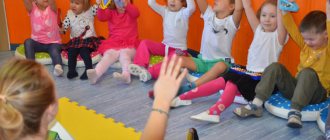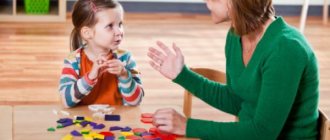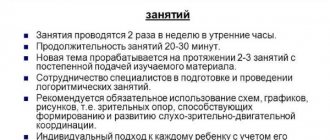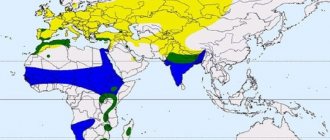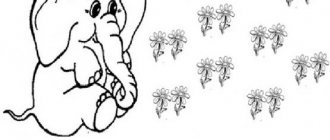Speech therapy rhythms in theory and practice are the focus of each of the publications in this thematic section. Here you can find useful tips and advice for teachers; ready-made notes for logorhythmic classes, theatrical performances, gymnastics and games.
You may find that special methodological developments on the use of logorhythmic exercises in integration with classes of a completely different focus will be useful in your work. Check out the positive experiences of your colleagues in children’s speech development and feel free to take note of them.
We develop speech, voice, memory using proven logorhythmic methods.
Contained in sections:
- The work of a speech therapist. Speech therapy 8475
By groups:
- Senior group
- Preparatory group
- Middle group
- Junior group
Showing publications 1-10 of 1483. All sections | Logorhythmics. Logorhythmic exercises
New
Photo
The best
Abstract of a logorhythmic lesson in the senior group “Winter Adventure” Synopsis of a logorhythmic lesson in the senior group The dominant educational area is speech Topic: “Winter Adventure”
Goal: Consolidating acquired pronunciation skills through development, education and correction of the motor sphere in combination with words and music. Correctively...
Logorhythmics for preschool children
Logorhythmics is a set of therapeutic exercises that includes elements of neurogymnastics. During classes , children perform various speech exercises using movements, words, and music. The goals and objectives of logorhythmics are to help children overcome speech disorders,...
Junior group. Early childhood, nursery. Children 1-4 years old
A game situation in a music lesson for children 3–4 years old with elements of logorhythmics as part of the project “Musical Logorhythmics” A game situation in a music lesson for children 3–4 years old with elements of logorhythmics as part of the project “Musical Logorhythmics for children 3–4 years old ”
Goal: Introduce children into a play situation; cause physical activity; develop a sense of rhythm; improve movements and perform...
Musical story lesson with elements of musical logori for children 3–4 years old
Musical story lesson with elements of musical logorhythmics for children 3-4 years old “Let's help grandparents”
Goal: to develop musical and speech abilities in children 3-4 years old, motor skills in combination with words and music. Objectives • to form clear coordination of movements...
Complex for children 5-6 years old
- Movement exercises It is better if the children themselves come up with movements to the poem that the teacher reads:
We will go to the forest today (children are walking), Who climbed the tree? (raise their heads up) Cuckoo? Cuckoo? (put hands to lips, repeat words) I’ll find you anyway
- Physical warm-up
Physical education to music. The poetic form of commands is used. Children gradually learn it by heart and pronounce it themselves.
The mouse ran quickly (we move one after another, slowly), The mouse wagged its tail (we repeat the movements of the animal), And dropped the egg (tilt down - lift up), Look, oh, it broke (we shake our heads, put our palms to our cheeks).
Logorhythmics in preschool educational institutions is used in any lesson: physical education, speech therapy, music. Teachers should pay attention to the pronunciation of auxiliary poems and words by children, and to the correct breathing of children during exercise.
Zheleznov's methods
Zheleznova’s finger exercises are one of the ways to conduct finger gymnastics and develop fine motor skills in a playful way. These games are ideal for children from two to five years old. All games are accompanied by funny songs and rhymes.
Playing finger games by Ekaterina Zheleznova, children receive various sensory impressions, learn to focus on any specific activity, and train attentiveness. The heroes of such games - rain and sun, butterfly and spider, goat and hare - delight 1.5-2 year old children. These characters help teach children to count and understand the meaning of the words “above”, “below”, “right”, “left”, “above”, “below”. How much the little one will like the game depends on how it is presented to adults. For the little ones, calmness, affection, care and caution in touch are of great importance.
For three to five year old children, the speech and expressiveness of an adult’s facial expressions are important, therefore, in order to recite a poem expressively, you will need to learn it by heart.
Advice The movements made by the right and left hands are controlled by different hemispheres of the brain. Therefore, first teach your child to perform the exercise with one hand, then with the other, and only after that with both at the same time.
Games where you need to act with your fingers in turns, for example, “2 red cockroaches” or “2 plump piglets,” can only be handled independently by children who are already four or five years old. A child under this age performs exercises only with the help of an adult.
How to practice
Recommendations for playing games:
- Pronounce the poems as expressively as possible, lowering and raising your voice while simultaneously performing the movements.
- It will be good to sing poetry to some melody.
- Do all the exercises with your baby, this will give you the opportunity to create the necessary mood, help the baby remember the movements and do them correctly.
- After several lessons, children usually begin to repeat parts of phrases after adults, and a little later - the entire poem, while correlating the movements with the spoken words.
- Don't be too demanding about your exercises. It won’t be easy for your child to recite a poem while doing the exercise at the same time. It is very important not to initially discourage your child from studying.
- Start with two or three games, gradually adding new ones. Over time, the baby will develop favorite exercises that he will be happy to return to many times.
- Under no circumstances force your child to play; try to find out the reason for the refusal and, if possible, eliminate it.
- Try not to focus on your child’s mistakes when doing exercises. But be sure to praise your child for the slightest success, this will push him to more significant achievements.
All finger games by Katya Zheleznova are carried out in three ways:
- the adult performs the movements, and the child observes;
- the adult makes movements with the baby’s hands;
- The baby makes movements with his own hands.
What is this
Volkova G.A., Shashkina G.R., Ekaterina Zheleznova studied the positive impact of rhythmic movements on speech together with the pronunciation of words and correct breathing in Russia. From their point of view, logorhythmics is a complex system of motor exercises aimed at eliminating speech anomalies in preschoolers and developing motor skills.
V.A. Gilyarovsky and N.A. Vlasova defined what logorhythmics is differently. In the mid-20th century, they studied the causes and methods of correcting logoneuroses. The main attention was paid to the word as a way to solve speech disorders. Rhythm and movement were given a secondary role. But they noted the usefulness of speech therapy rhythms for intellectual and aesthetic development.
In other words, logorhythmics is an activity that includes marching to rhythmic music, walking to a count, and running. Simultaneously with physical activity, the task is to control breathing, pronounce phrases, sing in a certain intonation, loudly or quietly, etc. Classes are held in an entertaining format, in a group or individually.
Speech therapy rhythms for speech development of preschoolers
F.Yu.SIEGEL
Introduction to the second issue of the collection “UFO Observations in the USSR”
“They laughed and denied quite a bit. It's easy and pleasant. But what a shame even now lies on humanity, which stifled the great, beat and destroyed what later turned out to be beneficial for itself. When will we “contemporaries” get rid of this disastrous vice for us?”
K.E.Tsiolkovsky
In March 1968, at the request of academician I. B.N. Petrov, the first issue of the handwritten collection “UFO Observations in the USSR” was presented to him for consideration. It contained 178 reports of UFO sightings over the Soviet Union, and in addition, outlined the history of UFO studies in the USSR. At a meeting on the UFO problem in the Central House of Journalists on February 5, 1968. acad. B.N. Petrov expressed the wish that all these materials about UFOs be discussed “at a round table”; This, in his opinion, would remove many puzzling questions. The collection I presented was carefully studied by Acad. B.N. Petrov and his employees. However, despite my urgent requests (during the year I turned to B.N. Petrov and his assistant E.D. Teryaev at least ten times), no promised discussion of the presented materials ever took place. I finally asked for the collection to be returned to me, believing that for Acad. B.N. Petrov is simply not interested in him and, given his busy schedule, he has no time to understand such an exotic issue as the UFO problem. However, B.N. Petrov asked me to give him the collection, which I, of course, willingly did. I admit that the situation that arose then seemed to me almost as mysterious as the UFO problem. If the presented academicians B.N. Petrov, UFO observations are actually observations of known objects (probe balloons, satellites, meteorites, etc.), then the easiest way would be to call me to your place and explain the resulting unfortunate misunderstanding using specific examples. On the other hand, if the presented collection, according to academician. B.N.Petrov, contains all kinds of nonsense (hoaxes, hallucinations, etc.), then in this case it was necessary to return it to me, as the notorious treatises on dizzying “hypotheses” are returned to their schizophrenic authors. But this was not done. The collection “UFO Observations in the USSR” (issue 1) was also presented by academician. V.A. Trapeznikov, who was keenly interested in the UFO problem before publication in Pravda on February 29, 1968. articles “Flying saucers again?” After this publication, he returned the submitted material about UFOs to me without any response. Over the following years, I gave the collection to a number of scientists to read, in particular prof. M.V.Melnikov and Ph.D. tech. Sciences V.P. Burdakov. They read the collection with great interest and asked to give them a copy, but avoided any specific explanations on the substance of the UFO observations. I am convinced (I will be glad if I am wrong) that everyone who has become acquainted with specific UFO observations and tried to explain them specifically has found themselves in the same difficulty as myself and all UFO researchers in general. General discussions around the UFO problem can satisfy only an extremely undemanding scientist in scientific terms. The second issue of the collection “UFO Observations in the USSR”, which is brought to the attention of the reader, is essentially an addition to the first. This issue also contains materials about some ground phenomena, possibly caused by UFOs. I hope that this issue, like the previous one, will help conscientious UFO researchers understand the essence of these mysterious and as yet unexplained natural phenomena. The UFO phenomenon awaits such Followers.
Recommendations for conducting classes
- Shape the lesson load according to the age and development level of preschoolers
- Give a lesson in the afternoon
- Change the topic of the lesson every week
- When selecting material, rely on lexical topics
- Use fairy tales and cartoons for speech and music exercises
- Exercise every day
- Accurately and clearly demonstrate to children the movements of their hands, body, and lips during phonation. Monitor the quality of assignments.
To solve your children’s speech problems, you don’t have to wait for help from a preschool education institution; work with your child at home. The logorhythmics technique is easy for any parent to learn.
Complexes for children 2-3 years old
Logorhythmics for kids involves the creation of special sets of exercises and entertaining activities. Games and exercises are performed using the method of imitation.
Animals
- Helps to get acquainted with the world of animals, insects, birds. Classes involve reading poetry, imitating walking movements, and animal sounds.
- Kids can walk like a bear, flap their wings like a swan, a sparrow, walk like a duck, etc.
- Onomatopoeia is required. The teacher asks: “How does a goose scream when it flies?” Pupils should wave their arms and answer: “HA-HA!”
- Pictures of animals and birds are used to help the speech therapist, teacher and parents.
- You can use the story with the bear and the cone:
The clumsy bear walks through the forest, collects cones and puts them in his pocket...
Children walk with their teacher, roar like a bear, and collect pine cones.
Vegetables and fruits
- They expand their knowledge of the world around them, the colors of fruits, and introduce them to their names.
- The following exercises are used for the lesson:
Salt the cabbage. The poem is read:
We cut the cabbage, cut it, We chop the cabbage, chop it...
Children make movements with their hands, pretending to be a knife or a hatchet.
We salt the cabbage, salt it, We press the cabbage, press it.
And we'll grate the carrots.
They depict how they stir, salt, and squeeze chopped vegetables.
- Let's go to the garden
Pictures depicting garden vegetables and garden fruits are used. First, you should have a conversation, tell preschoolers about where vegetables and fruits grow, what color they are, how they smell, etc.
Then a scene of a trip to the garden to collect the harvest is depicted. You can use fruit toys that the children will pick from trees and collect from beds. A competition game is suitable: children are divided into 2 teams, toy fruits are laid out around the room. The teacher asks each team to find as many fruits from one group as possible: for example, vegetables. Children take turns looking for them and bringing them to their basket.
